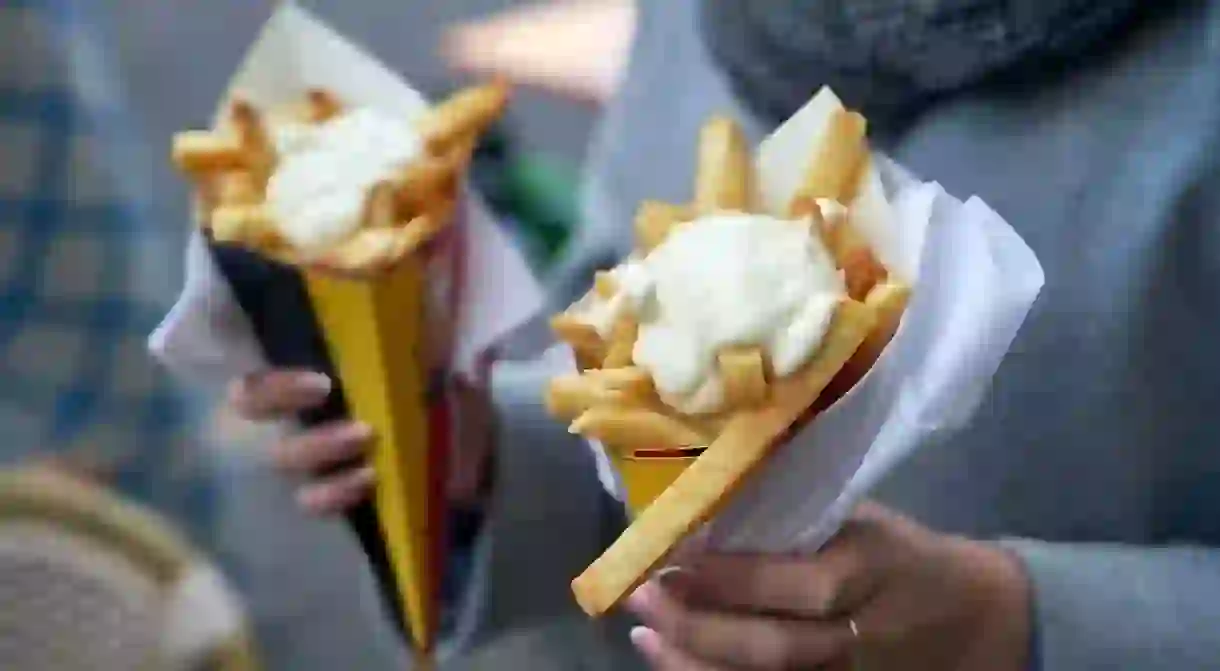The 10 Best Places for Belgian Fries in Brussels

The French claim they invented fries; so do the Belgians. But let’s focus on something we can (nearly) all agree on. Fries, known as frites to Belgians and chips to the English, are a delicious snack and form the perfect accompaniment to a burger. To make sure you eat the best fries when you’re next in Brussels, head to one of these top kiosks.
Exploring Brussels and looking for the best eats in town? Let a local expert show you the culinary ropes by booking a guided food tour in the Belgian capital.
Frit Flagey
Their golden, melt-on-your-tongue potato sticks mean that Frit Flagey is often named (along with several others) the best place to find fries in the city. Unequivocal evidence of their popularity comes from a 2011 Facebook campaign which saved Frit Flagey from shutting down. Its success meant that the owner moved the business to another place and its loyal customers duly followed. Make sure you visit to see what all the fuss is about.
Friterie de la Barrière
After a few beers and late-night partying, fries are a great snack when celebrations come to a close. But where to go when it’s 3am? Luckily, Friterie de la Barrière ensures it’s never too late to satisfy your hunger. This place is open until 5am, sometimes it even makes it to 7am. The fritkot (fries kiosk) is a traditional, dark old-school shed – you’ll find it by following the smell of frying late at night.
Friterie du Café Georgette
Friterie du Café Georgette’s secret to producing tasty fries is to fry them in three types of oil, each heated to a different temperature. The service is really efficient here, and they are located close to the centre of town, so you don’t have to make a detour to find great fries. Order a Belgian beer to drink with them and a special sauce called georgette for dipping.
Maison Antoine
Another friterie that claims the number one spot is Maison Antoine, which provides big portions of fries, all crispy on the outside and soft on the inside. Best of all, most of the bars surrounding Maison Antoine allow the fries to be eaten on their premises. The queue will be long, but don’t worry, its length just illustrates how much people love this place and your purchase will be well worth the wait.
Chez Eugene
Some fries are so tasty that making a long trip is worth the effort. Chez Eugene in Uccle is not as popular as other places in the centre of Brussels, which may appeal to those who are impatient. The great fries speak for themselves. Although the owners don’t use social media to market the kiosk, it still has a solid reputation.
Chez Clémentine
This kiosk in Uccle has been in operation for more than 20 years. Its popularity comes as no surprise as it was created by Clémentine, the daughter of the Maison Antoine founder – and it’s obvious that these two places share a recipe for success. Pair the fries with a hamburger and you have a match made in heaven.
Fritland
Right in the heart of city centre, near Bourse, you will find Fritland. This place is no newcomer to the friterie (fries) scene, having been in business for at least 40 years. There are not many places in Brussels that don’t use frozen fries but Fritland is one of them. They receive new potatoes daily so their fries are always fresh.
Friterie du Miroir
Even though this place is not in the heart of the city, lovers of fries have found it, so the queues may be similar to those in the city centre. This place prepares fresh fries from scratch, ensuring that they are perfectly crispy. During sunny days, you can sit in front of the fritkot (fries kiosk) and enjoy the atmosphere while pulling one salty fry after another from the paper cone.
Friterie Tabora
In Brussels, wherever you see a great fritkot (fries kiosk), there’s always a huge queue, which means you will always be able to spot the best places to buy fries. It’s a rule that holds true for Friterie Tabora. There’ll be a long line, but be patient because it will lead to some of the best, hot, crunchy, golden delicacies in the city.
Friterie Atomium
At Friterie Atomium, you can gawp at one of Belgium’s national treasures while gulping down another. This highly-rated food stand is right next to the Atomium landmark, a 102m (334ft)-high reflective sculpture depicting an iron crystal cell.













